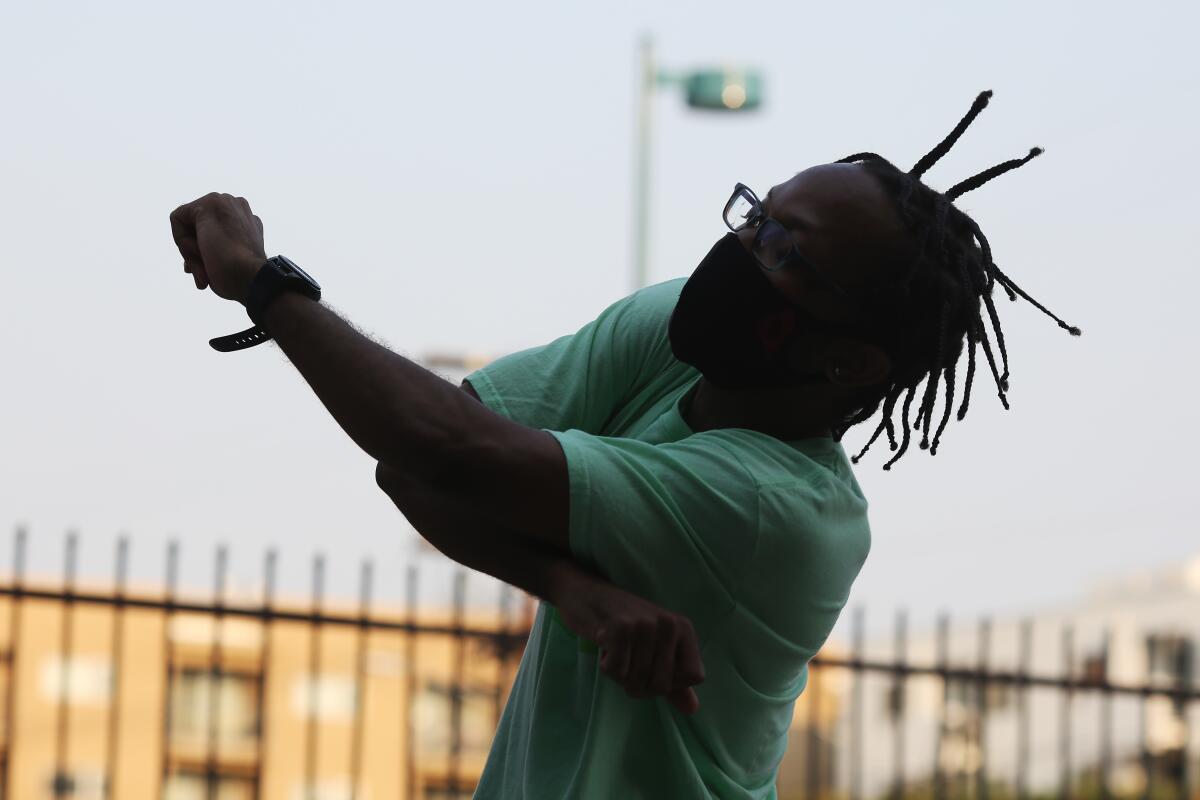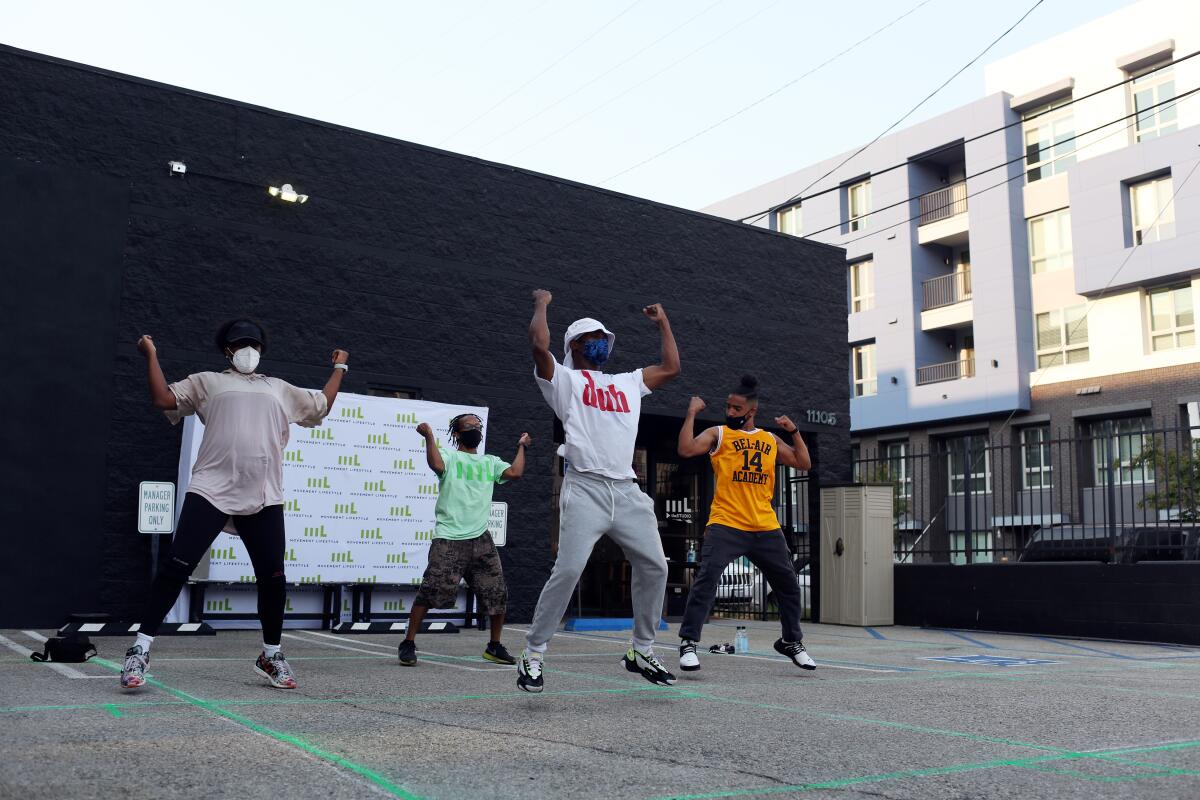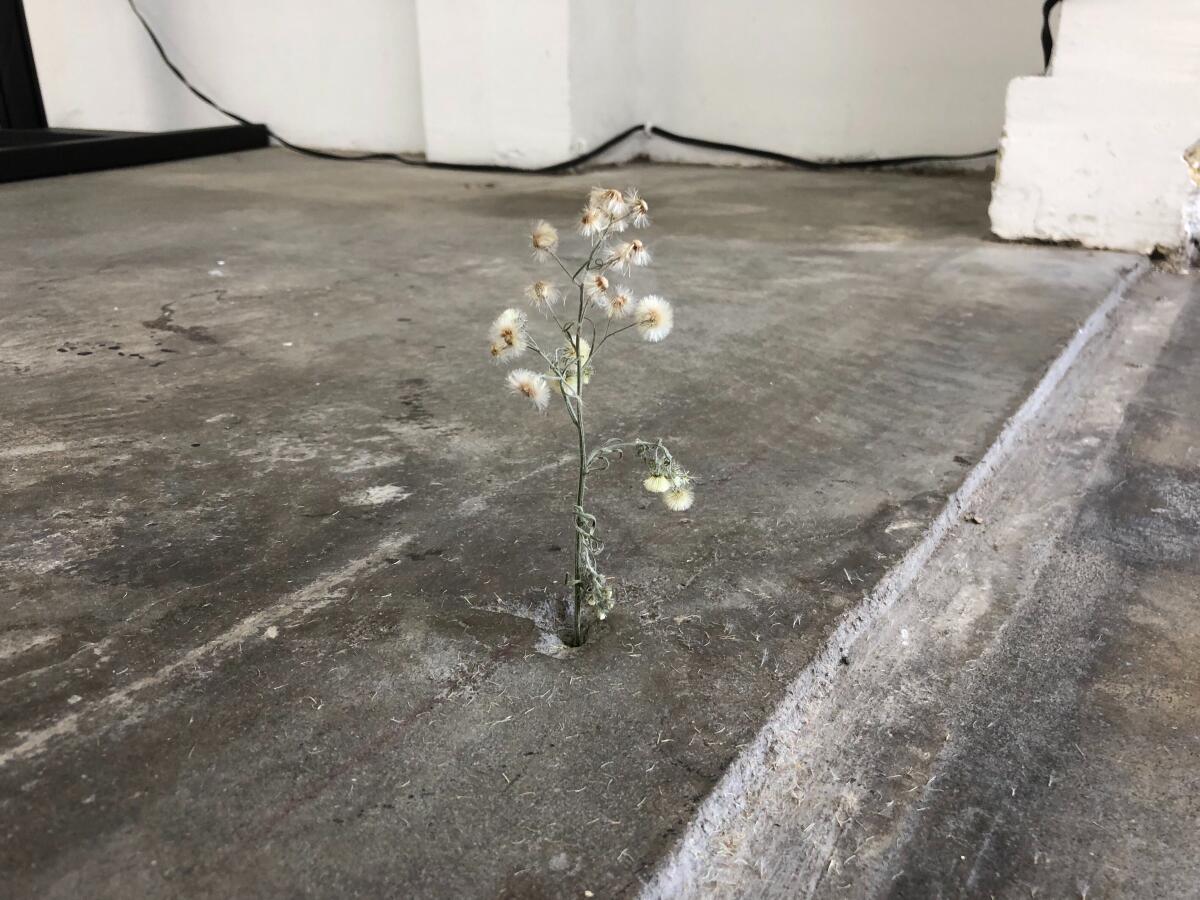Essential Arts: L.A. dance studios in crisis

- Share via
Welcome to the Labor Day climate oven, for which I’ve prepared by acquiring an inflatable pool and all of the cider at my local market. I’m Carolina A. Miranda, staff writer at the Los Angeles Times with the week’s culture news — and confirmation that I am not an impostor.
Dance, dance ... dance?
The Times’ Makeda Easter has an essential report about how L.A. dance studios are weathering the pandemic. The answer: not well. Pieter Performance Space in Lincoln Heights, the Sweat Spot in Silver Lake (founded by Ryan Heffington, the choreographer behind Sia’s “Chandelier” video) and Edge Performing Arts Center in Hollywood have all permanently closed their physical spaces. As Easter notes, “Even before the pandemic, running a dance studio in L.A. was notoriously challenging.” Now a raft of “other spaces on the brink of closing are fighting to survive the near future.”

Design time
SoFi Stadium is set to open in less than two weeks in Inglewood after more than five years of design and construction. Times contributor Sam Lubell has a look at the new football stadium, designed by HKS Architects, and says it has the potential to be “revolutionary.” “This stadium is not really a stadium,” Lubell writes. “It’s not a solid concrete and steel bowl where fans park cars and push their way in and out eight times a year. And it’s not a themed shopping mall and mini amusement park grafted onto a sports facility.”

Speaking of design and sports: The Times’ David Wharton has a look at a new series of logos for the 2028 Olympics in Los Angeles. Rather than settling on one logo, LA28 organizers invited more than two dozen designers to come up with their own interpretations of the “A” in “LA28” — with more to come in the future. “It might not seem like a big deal,” he writes. “But the process generated something stylized and highly individual, which makes it an oddity in an Olympic world that is usually conservative and protective of its brand.”
Make the most of L.A.
Get our guide to events and happenings in the SoCal arts scene. In your inbox every Monday and Friday morning.
You may occasionally receive promotional content from the Los Angeles Times.
Plus, in December, the City of L.A. designed a competition to find a new design for its standard streetlight (the first across-the-board revamp since the 1950s). Now The Times’ Jessica Gelt reports on the winners — an L.A.-based collective called Project Room that is made up of Isaac Resnikoff, Sumit Sahdev, Sandy Yum and Joakim Dahlqvist. The design, called “Superbloom,” is bigger at the bottom and more slender toward the top, with a loop that curves like a vine. Expect to see the new design on city streets starting in 2021.
Gelt also rounds up some of the finalists, including designs by SWIV and Brooks + Scarpa, RIO among other designers and organizations. The designs span the range from curvy to blocky to futuristic.
As Laura Bliss points out in Bloomberg CityLab, however, tech-laden street lights such as these can also be a fraught subject since they are also used as “mounts for security cameras, gunshot detectors, and other surveillance tools.” The new design can accommodate “smart city” technologies that have led to backlashes over surveillance in other Southern California communities.
Breonna Taylor’s power portrait
Vanity Fair debuted a remarkable artist-made cover for its September issue: a portrait of Breonna Taylor, the Louisville EMT who was shot to death by police in March in the hallway of her apartment. Times art critic Christopher Knight evaluates the piece, painted by Baltimore-based artist Amy Sherald, who quite famously painted the portrait of Michelle Obama now in the National Portrait Gallery. “The result is powerful,” he writes, “Breonna Taylor rendered as a Nike, a fierce icon of victory.”
The Tao of Turandot
“What makes ‘Turandot’ a true Chinese opera is not that it sounds Chinese but it follows the Tao. The orchestra is like the sky above and the ocean below, hurling clouds and surging waves, ever changing, ear-catching in colors and surprising in harmonies that don’t predictably resolve, keeping you off guard just often enough.” This week, Times classical music critic Mark Swed is giving Puccini’s incomplete opera “Turandot” a deep listen.
You can find Swed’s entire “How to Listen” series right here.
Coronavirus and the arts
In the early days of the pandemic, director Richard Kraft helped organize the “Soundtrack of Our Lives,” a concert staged in support of the MusicCares COVID-19 relief fund, administered by the National Academy of Recording Arts and Sciences. The event, which featured appearances by the likes of Catherine O’Hara, Patti LuPone, Danny Elfman and even Kermit the Frog, will be available to stream through Sept. 25. This early pandemic show is a reminder of how “home-bound audiences have become accustomed to watching virtual productions of all kinds,” reports Jessica Gelt, and how the productions have grown increasingly sophisticated ever since.
Gelt also reports that the pandemic has forced the Center Theatre Group to lay off 91 previously furloughed employees, a mix of full- and part-time staffers accounting for more than half of its workforce. “The layoffs take effect at the end of September,” she writes, “and hit hardest the market and sales teams of CTG.”
Plus, SFMOMA has announced furloughs for all full-time and some part-time employees, resulting in a 20% reduction of hours and pay. The museum currently employs 343 people, down from nearly 500 at the beginning of the year.
A staff reorganization at the Walker Art Center in Minneapolis has resulted in the closing of its online magazine, the Walker Reader. That is unfortunate. The site, led by journalist Paul Schmelzer, produced interesting arts coverage in ways that were topical without being self-promotional, featuring contributions by important art world figures such as Jack Whitten, Hans Haacke, Taylor Renee Aldridge and Jessica Lynne. I’ve always thought of it as a model for what museums might do to support arts writing at a time when media is shriveling. I’m sorry to see it go.
Meanwhile, with the reopening last week of New York’s Metropolitan Museum of Art — with strict limits on crowd sizes, as well as social distancing and mask requirements and plenty of hand sanitizer — Hakim Bishara of Hyperallergic found folks who were relieved (about getting out of the house) and pleasantly surprised at being able to see art without typical Met crowds.
Enjoying this newsletter? Consider subscribing to the Los Angeles Times
Your support helps us deliver the news that matters most. Become a subscriber.
Architecture writer Clifford Pearson has an idea for a memorial to COVID-19: House it in the Romanesque Revival building in Washington, D.C., which once housed the city’s main General Post Office and now harbors a Trump International Hotel. “Most residents of D.C.,” he notes, “still call it the Old Post Office. It is nothing if not a survivor. And thanks to the gutting of its original function, it is an apt symbol of our current moment.”
Essential happenings
It’s going to be a scorcher this weekend and Matt Cooper is ready with 15 culture picks for the Labor Day weekend (that you can enjoy in the comfort of AC), including a virtual adults-only show by Lucha VaVoom — featuring appearances by Patton Oswalt, Andy Richter and Drew Carey — and staged in partnership with KCRW.
I recently tooled over to the new community arts space Crenshaw Dairy Mart in Inglewood to check out its exhibition “Yes on R,” curated by Autumn Breon Williams and Alexandre Dorriz. The show examines nine years of activist labor related to the passage of Measure R, a ballot initiative that called for increased oversight of the L.A. County Sheriff’s Department. The topic couldn’t be more timely given the killing of Black cyclist Dijon Kizzee by deputies earlier this week.
The show includes documentation, ephemera and work by artists and activists (including Dairy Mart co-founder Patrisse Cullors, who has long been engaged in justice reform causes). The show provides a good opportunity to reflect on the long-term commitment and dedication necessary to effect change. But I was particularly moved by one of the smaller gestures: a dandelion placed in the crack on the floor, a poignant symbol of resilience.

As Cullors told Art in Odd Places in 2013: “The dandelion is kind of seen as abused, people will kick it up in their yard when they see it grow in their garden ... you try to uproot it and it gets stronger, so it grows deeper. ... We thought that was a powerful image for us — even if you try and beat us and uproot us, we will get stronger, we will survive.”
You can see the show online or by booking an appointment via Crenshaw Dairy Mart’s website.
Passages
Siah Armajani, an Iranian-born artist whose public sculptures also served as architecture and places of gathering, has died at 81 at his home in Minneapolis.
In other news
— The Corita Art Center is trying to get the former Hollywood studio of the late graphic artist Corita Kent designated a Historic-Cultural Monument. The building faces possible demolition.
— The Marciano Art Foundation will be renting its space to Gagosian — leading to the very good question from art writer Matt Stromberg: what of the organization’s nonprofit status?
— Richard Rogers, 87, the architect renowned for his work on the Pompidou Centre in Paris and the Lloyd’s building in London, is retiring from the firm he helped found more than four decades ago.
— Frances Anderton interviews architect Lance Collins, president of the Southern California branch of the National Organization of Minority Architects, about his organization’s efforts to diversify the architectural profession. Black architects make up only 2% of architects nationally. (Starts at the 8:45 mark.)
— Alissa Walker has an interesting piece on why it’s a good time to take down the D.W. Griffith monuments at the Hollywood & Highland shopping center.
— “This landscape design, like so much of the televisual imagery, reflects the Trumpist shrinking of governance to personal interest, private wealth, and images of whiteness.” Mitch McEwan picks apart the new White House Rose Garden.
— In the 19th century, German colonial forces looted a traditional object known as a “Tangue” in Cameroon. But its return is mired in bureaucracy, much of it having to do with who it should be restituted to.
— Speaking of Germans, Alex Ross has a fascinating piece on how composer Richard Wagner shaped Hollywood and Hollywood scores.
— Misty Copeland’s house gets the Architectural Digest treatment.
And last but not least ...
Curator and historian Josh Kun made a playlist inspired by the Chicano Moratorium and it’s pretty darn groovy.
The biggest entertainment stories
Get our big stories about Hollywood, film, television, music, arts, culture and more right in your inbox as soon as they publish.
You may occasionally receive promotional content from the Los Angeles Times.




